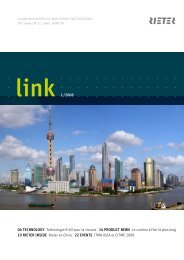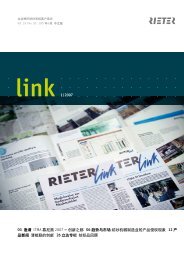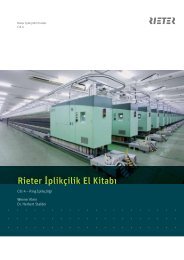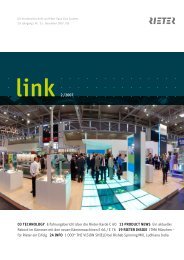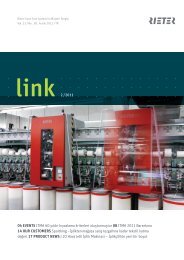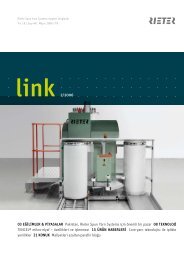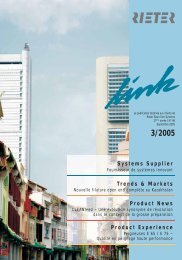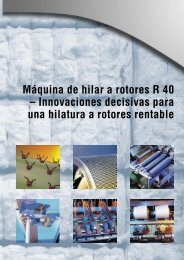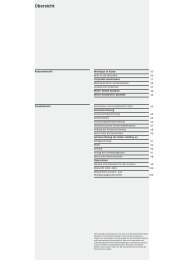c - Rieter
c - Rieter
c - Rieter
You also want an ePaper? Increase the reach of your titles
YUMPU automatically turns print PDFs into web optimized ePapers that Google loves.
ELWIS<br />
Porous material analyser system for<br />
Acoustical and Structural parameters.
The ELWIS porous material analyser<br />
-2-<br />
The ELWIS (Evaluation of Light Weight Impedance System) measurement system comprises<br />
an ELWIS-A system for the evaluation of the Acoustic parameters and an ELWIS-S<br />
system for the evaluation of the Structural parameters together with an acquisition unit including<br />
the acquisition cards and a PC.<br />
The system permits the physical parameters of porous materials to be determined in a rapid,<br />
reliable and convenient way.<br />
ELWIS-A also fulfils the ASTM (E-1050) and ISO (10534-1/2) standards for impedance tube<br />
measurements (measurement between 200 and 3400 Hz).<br />
The ELWIS-A and ELWIS-S systems are described in more detail in separate brochures.<br />
Porous material parameter measurements<br />
As it is well known, the simulation of the physical behaviour of porous materials by means of<br />
the Biot-Allard model requires the knowledge of a set of material parameters. These parameters<br />
are essentially needed both for the characterisation of the material structural frame<br />
of foam and felt, and of the air that saturates it and also for the characterisation of the inertial<br />
and dynamic coupling between them.<br />
These parameters are required in the following situations:<br />
Acoustic performance evaluation:<br />
The Biot-Allard model is used when evaluating the macroscopic acoustic performances of<br />
sound insulating and sound absorbing multi-layer treatments using software tools (e.g. SI-<br />
SAB, developed by <strong>Rieter</strong>).<br />
- Can be used to compare quickly the performances of different sound package solutions<br />
or materials<br />
- Widely used in vehicle airborne noise SEA models.<br />
Finite Element simulations<br />
The Biot-Allard model is used when simulating the dynamical and acoustical behaviour of<br />
real finite-size sound package parts in the medium to low frequency range<br />
- FE simulations with software such as Actran, Nastran, Rayon, …<br />
<strong>Rieter</strong> Automotive Management AG 16/08/2007
The Biot parameters to be measured<br />
The acoustical Biot-Allard parameters:<br />
The structural Biot-Allard parameters:<br />
-3-<br />
Parameter Symbol Unit S.I.<br />
Composite porosity φ [-]<br />
Air flow resistivity (AFR) σ [Pa s m -2 ]<br />
Composite tortuosity τ [-]<br />
Composite pore shape factor c [-]<br />
Viscous characteristic length Λ [m]<br />
Thermal characteristic length Λ '<br />
<strong>Rieter</strong> Automotive Management AG 16/08/2007<br />
[m]<br />
Parameter Symbol Unit S.I.<br />
Young’s Modulus E [Pa]<br />
Damping Loss Factor (DLF) η [-]<br />
Poisson’s ratio (for foam materials)<br />
(Range: 0.15-0.48)<br />
It is necessary to measure these parameters in a rapid and robust way<br />
- Since the results of the simulations based on the Biot-Allard model can be rather sensitive<br />
to variations in one or more of these parameters;<br />
- During the development or the analysis of a sound package part, it is generally necessary<br />
to compare several different solutions quickly and this requires, in principle, the<br />
availability of large material parameter databases. The construction of such databases<br />
by means of classical and direct techniques is a rather long and delicate process<br />
The ELWIS-A methodology requires only the separate measurement or calculation of<br />
the porosity.<br />
ν<br />
[-]
Parameter<br />
Porosity<br />
AFR<br />
Tortuosity<br />
Viscous Length<br />
Thermal Length<br />
Pore shape<br />
factor<br />
Normal<br />
absorption<br />
Surface<br />
impedance<br />
Young’s modulus<br />
Loss factor<br />
Poisson ration<br />
φφ<br />
σσ<br />
ττ<br />
Λ<br />
Λ '<br />
c<br />
αα<br />
Z<br />
E<br />
η<br />
ν<br />
System Specifications available on request<br />
-4-<br />
Without ELWIS<br />
RIETER PORPOS<br />
RIETER AFR<br />
Estimated/<br />
or<br />
- Ultrasonic methods<br />
- Identification methods<br />
Impedance tube<br />
Impedance Tube<br />
Resonant Method<br />
Resonant Method<br />
Estimated<br />
With ELWIS<br />
system<br />
RIETER PORPOS<br />
ELWIS-A<br />
ELWIS-A<br />
ELWIS-A<br />
ELWIS-A<br />
ELWIS-A<br />
ELWIS-A<br />
ELWIS-A<br />
ELWIS-S<br />
ELWIS-S<br />
ELWIS-S<br />
Select the "contacts" link on our website (www.rieter.com) for further information<br />
<strong>Rieter</strong> Automotive Management AG 16/08/2007<br />
��<br />
��<br />
��<br />
��<br />
��<br />
��<br />
��<br />
��<br />
��<br />
��



